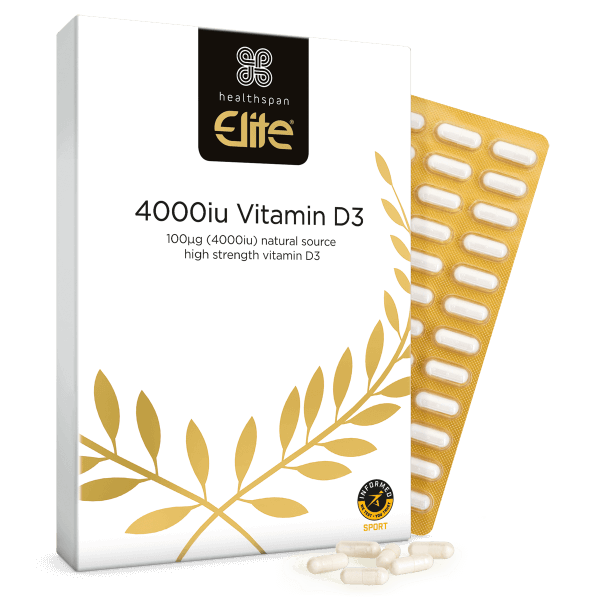Vitamin D supports immunity, muscles and bone health, so is particularly important for staying well and maintaining sports performance in the winter. Registered Dietitian and Performance Nutritionist Ruth Wood-Martin examines the evidence.
🕒 8 min read
A huge amount of vitamin D research has been published over the past decade, and this has helped shape how we think about its role in health and performance.
Findings in the last five years have been mainly limited to dose recommendations, but it's nonetheless vital to remember how important this vitamin is for health, wellbeing and performance. As we approach the time of year when our best source of the vitamin – UVB radiation from sunlight – declines, it's time to take action to maintain vitamin D levels throughout the winter months.
Sources of vitamin D
There are two natural sources of vitamin D – ergocalciferol (vitamin D2) and cholecalciferol (vitamin D3). Dietary sources of both forms of the vitamin are limited, with the exception of oily fish such as salmon, mackerel and sardines, which is a good source of vitamin D3.
However, the main source of vitamin D3 comes from the reaction of UVB radiation from sunlight with a protein in our skin. Both vitamins D2 and D3 are transported to the liver and then the kidneys, where the active form of vitamin D is formed ready for use.
Populations at risk of deficiency
In the summer months, it's likely that the general population will get sufficient vitamin D from spending time outdoors; however, at certain times of the year, geographical location will determine whether the sunlight is strong enough to enable the skin to manufacture vitamin D.
Those living in latitudes greater than 40 degrees north or south of the equator will have less exposure during their winter months (between October and March in the UK and Ireland). Other factors limiting vitamin D manufacture include clothing that covers the skin, ethnicity and ageing skin.
Athletes who train and compete indoors may be more at risk of insufficient sun exposure to manufacture enough vitamin D to maintain blood levels.

Vitamin D3 1000iu
1,000iu natural source Vitamin D3 to support immunity, muscles & bones
- Supports your immune, muscle and bone health
- 1000iu (25mcg) of vitamin D3, the body-ready form
- One-a-day formulation, suitable for vegetarians
Vitamin D levels and classification
Classification of vitamin D levels is controversial, and agreement on what constitutes deficiency is under constant debate.
The US National Academy of Medicine (previously the Institute of Medicine) has been the go-to reference for vitamin D status classification (Table 1), but it has been argued that these guidelines were developed based on the estimated average requirement (EAR) for vitamin D, centred solely on its role in bone health.
A large body of research has shown that bone health is only one functional role for vitamin D, leading to the debate on what is actually the optimal vitamin status.
Also, what is 'optimal' for the general population may differ from what is optimal for athletes training and competing at elite levels. A 2018 research paper suggests that athletes' vitamin D levels should aim to be maintained at a concentration greater than 75 nanomoles per litre (>75nmol/L.)
Institute of Medicine guidelines for classification of Vitamin D status
Vitamin D nmol/L | Institute of Medicine classification |
Less than 12.5 | Severely deficient |
12.5 – Less than 30 | Deficient |
30 – 50 | Inadequate |
More than 50 | Adequate |
More than 180 | Toxic |
Deficiency data
Over the past 10+ years, there has been emerging evidence that vitamin D insufficiency and deficiency is evident both in the general and sports populations.
This has prompted public health organisations to review recommended daily intakes and tolerable upper limits for the general population. Public Health England (PHE) and the National Institute for Health and Care Excellence (NICE) acknowledge that supplementation is necessary during the winter months, especially for vulnerable people.
The Food Safety Authority of Ireland (FSAI) published a report in 2023 that recommended supplementation of Vitamin D throughout the winter months, and all year round for vulnerable individuals.
As most vitamin D is made by the skin on contact with the sun, deficiency can be a problem in the winter, especially in northern latitudes. Nutritionist Rob Hobson explains why keeping your vitamin D levels up is important for sports performance.
Key considerations for athletes in relation to Vitamin D
Health and wellbeing
Athletes and sportspeople are subject to health challenges just like the general population. In relation to vitamin D, there is evidence that deficiency has multiple long-term adverse cardiac effects. Vitamin D deficiency negatively affects cardiac contractility, vascular tone, collagen content and cardiac tissue maturation.
Despite the relationship between vitamin D and cardiac function, and the fact that many professional athletes are deficient in vitamin D, there are few studies that have examined this relationship in healthy athletes.
Athletes and non-athletes alike are either positively or negatively affected by their mood and sleep quality. Vitamin D is involved in serotonin and melatonin regulation, and research suggests that improving vitamin D status may be helpful in improving mood and sleep quality.
A literature review revealed mixed results, but because of clear links between vitamin D and pathways that affect sleep and mood, more targeted research is recommended.

Vitamin D3 Spray 4000iu
High-strength vitamin D3 spray to support immunity, muscles & bones
- Fast-acting for maximum absorption
- 4000iu (25mcg) of vitamin D3
- Convenient, tasty peppermint spray
Bone health and fracture risk
An adequate amount of calcium and vitamin D is required for the growth, development and integrity of bones. Vitamin D essentially facilitates the absorption of calcium to support bone mineralisation (helping bone mineral density, or BMD) and bone turnover (the process of bone breakdown and renewal.)
Low vitamin D levels are also associated with raised parathyroid hormone (PTH), which can cause excessive mobilisation of calcium from bone, thereby reducing BMD – a problem, as BMD is critical to maintain bone strength.
However, there is a poor relationship between BMD and vitamin D in athletic populations; it may be that the stimulus of weight-bearing activities associated with athletic training somewhat compensates for lower vitamin D levels.
Despite these findings, it is prudent practice to maintain athletes' vitamin D levels above 50nmol/L (especially in those at risk of stress fracture), even though exact levels to optimise bone health are unclear.
Muscle function
The evidence regarding muscle function is equivocal. Some studies show no benefit of supplementation, although subjects in these studies would not have been classified as deficient by IoM guidelines.
In athletes with vitamin D levels greater than 50nmol/L at baseline, a study by Close et al found improvements in 10m sprint times and vertical jump height following supplementation. It appears that problems with muscle function are only seen in athletes with very low vitamin D levels (less than 20nmol/L), with no evidence to date to show benefits with levels above that normally seen in the body (above 75nmol/L).
However, there is emerging evidence that there may be benefits in increasing vitamin D levels above 75nmol/L in order to support muscle remodelling following skeletal muscle injury. Another study suggests that maintaining higher vitamin D levels may be beneficial in enhancing reparative processes, with the potential for subsequent muscle development.
Immune support
Vitamin D insufficiency is associated with higher levels of diseases, including common colds, influenza and gastroenteritis.
A landmark 2011 study showed that for every 10nmol/L increase in vitamin D levels, there was an associated 7% reduction in infection risk. Another study reported that vitamin D supplementation during 16 weeks of winter training significantly reduced infection risk.
Following injury, the most time lost to training in athletes is due to illness, especially upper respiratory tract infections (URTIs), so research is suggesting that athletes maintain vitamin D levels above 75nmol/L throughout the year to reduce risk of illness.

Vitamin D3 4000iu
4,000iu natural source Vitamin D3 to support immunity, muscles & bones
- Supports your immune, muscle and bone health
- 4000iu (25mcg) of vitamin D3, the body-ready form
- Vitamin D supplementation recommended by UK Government during winter months
Role of supplementation
As explained above, the main source of vitamin D comes from exposure to sunlight. Indeed, large-scale investigations have shown than less than 2% of the population get sufficient vitamin D from food. Sunlight synthesis produces vitamin D3, whereas food sources provide both vitamin D2 and D3. Vitamin D3 is much more potent in overcoming deficiency and is the preferred vitamin D supplement form.
PHE and NICE in England, as well as FSAI in Ireland both recommend supplementation during the winter months to meet requirements in the general population. Vulnerable groups are advised to supplement all year round.
Supplementation is a highly effective way of providing sufficient vitamin D. Vitamin D3 is the most effective supplement form, and levels will be listed on the supplement product in microgrammes (µg) or international units (IU). 1µg of vitamin D = 40IU.
So how much vitamin D is enough for sportspeople, and can they take too much?
The amount of supplementation an athlete needs depends on many factors. To maintain levels greater than 75nmol/L, those who train and compete indoors (such as boxers, swimmers and gymnasts) may require more than athletes who are routinely outdoors. Those who have dark skin or who cover their skin when outside may also need more.
For this reason blanket approaches to supplementation with mega doses are to be avoided; there is no evidence that taking supplemental doses to raise blood concentrations higher than 75nmol/L would have any performance-enhancing effect. In fact, it may be harmful. The European Food Safety Authority (EFSA) has set tolerable upper limits for daily intake for adults at 100µg (4000IU).
Athletes at risk of vitamin D deficiency should have a blood test to establish their vitamin D level in order to supplement with the correct dose to correct any inadequacy. Researchers have developed a useful vitamin D supplementation decision tree to provide guidance to practitioners on supplemental amounts, including for those where testing is not possible.
Dose and duration of supplementation requires careful consideration. Some athletes undertake warm weather training during the winter months, which will provide them with a top-up of vitamin D3 from the skin, so care should be taken not to over-supplement.
For the reasons above, most evidence supports supplementation ranging from 1000IU to 4000IU/day (25µg to 100µg), particularly during the winter months. The interest in the role of vitamin D in health and performance continues to evolve.









